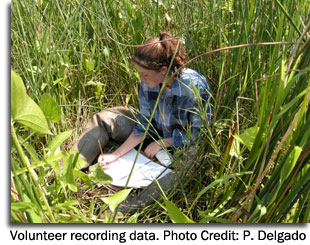 CBNERR-MD is monitoring marsh plants as part of an effort to better understand their change over time and their responses to natural and human stressors such as storms, invasive species, and land use and climate changes. Marsh plants are rooted plants that often grow in estuaries - areas where the rivers meet the sea. Because of this, they are influenced by salt and tides, although tidal freshwater marshes are only influenced by tides. Tidal marshes are flooded at high tide but dry during low tide. How often and for how long a marsh floods is dependent on its location and elevation. Marshes close to water channels are often at lower elevations and are therefore flooded for longer periods of time than marshes located at higher elevations and farther away from the water. Marsh salinity and flooding characteristics are what make marsh plants so unique. Marsh plants play an essential role in estuarine systems. They serve as buffer zones by reducing the energy and water movement from storms, their roots stabilize marsh sediments, they are important to reduce nutrients from the water, and also provide food, shelter, and habitat for many animals including fish, reptiles, amphibians, mammals, and birds.
CBNERR-MD is monitoring marsh plants as part of an effort to better understand their change over time and their responses to natural and human stressors such as storms, invasive species, and land use and climate changes. Marsh plants are rooted plants that often grow in estuaries - areas where the rivers meet the sea. Because of this, they are influenced by salt and tides, although tidal freshwater marshes are only influenced by tides. Tidal marshes are flooded at high tide but dry during low tide. How often and for how long a marsh floods is dependent on its location and elevation. Marshes close to water channels are often at lower elevations and are therefore flooded for longer periods of time than marshes located at higher elevations and farther away from the water. Marsh salinity and flooding characteristics are what make marsh plants so unique. Marsh plants play an essential role in estuarine systems. They serve as buffer zones by reducing the energy and water movement from storms, their roots stabilize marsh sediments, they are important to reduce nutrients from the water, and also provide food, shelter, and habitat for many animals including fish, reptiles, amphibians, mammals, and birds.
 Marsh plants are currently being surveyed in the three CBNERR-MD components: Otter Point Creek, Jug Bay, and Monie Bay. In 2008, fifteen transects were established in each of the tidal freshwater marshes at Otter Point Creek and Jug Bay, and in 2010 six transects were established in the Monie Bay brackish marshes. Transects are sampled once during the growing season using the Point Intercept method, which provides information on species presence (diversity) and their ground cover. Other parameters also measured include number of individuals per species (density) and species maximum height.
Marsh plants are currently being surveyed in the three CBNERR-MD components: Otter Point Creek, Jug Bay, and Monie Bay. In 2008, fifteen transects were established in each of the tidal freshwater marshes at Otter Point Creek and Jug Bay, and in 2010 six transects were established in the Monie Bay brackish marshes. Transects are sampled once during the growing season using the Point Intercept method, which provides information on species presence (diversity) and their ground cover. Other parameters also measured include number of individuals per species (density) and species maximum height.
The main objectives of this project are to:
- Better understand the impacts of human and natural stressors in marsh plant communities.
- Promote the use of long-term monitoring data to manage and protect CBNERR-MD marsh communities.
- Promote the use of long-term monitoring data for education and stewardship purposes.
Previous surveys have shown spatter dock, cattail, arrow arum, sweetflag, tearthumb, jewelweed, and wild rice as some characteristic freshwater marsh species. Characteristic brackish marsh species include salt marsh cordgrass, salt meadow cordgrass, marsh spikegrass, and black needlerush.

How to Get Involved:
If you are interested in helping with our marsh plant monitoring effort please contact CBNERR-MD Research Assistant, Lindsay Carroll (lcarroll@dnr.state.md.us). Sampling involves long days trekking in the marsh identifying plants and note-taking. Ultimately, it is a great opportunity to enjoy the natural beauty of these unique communities.
Available Information:
If you are interested in obtaining data collected through these efforts, please contact Stewardship Coordinator, Chris Snow (chris.snow@maryland.gov)